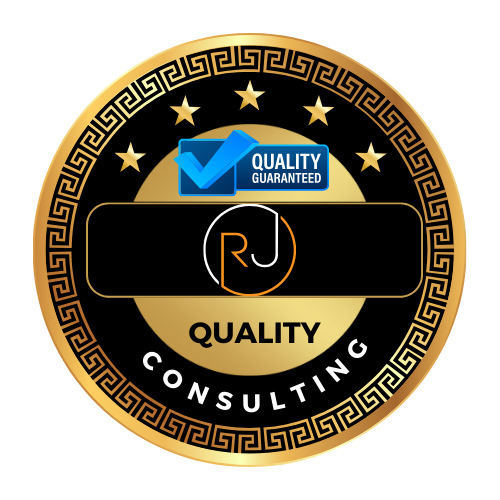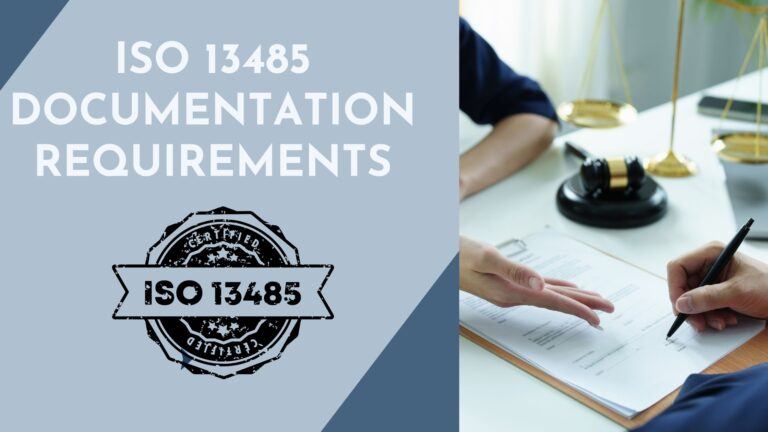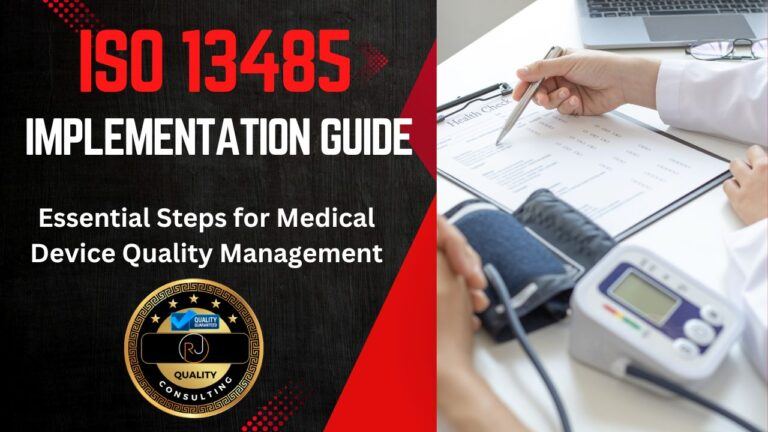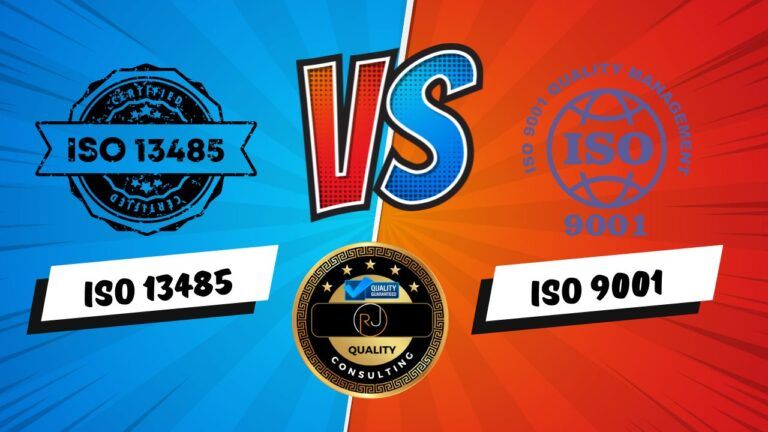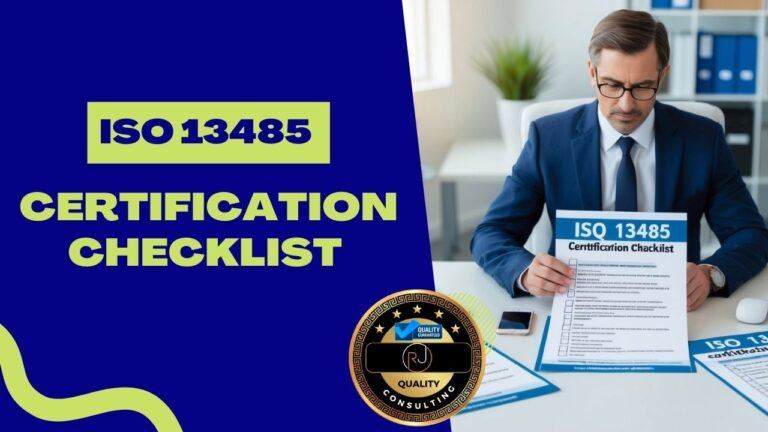ISO 13485 Certification Requirements: Essential Steps for Medical Device Quality Management
ISO 13485 certification proves a company’s commitment to quality in medical device manufacturing. This standard sets rules for creating and keeping a quality management system. Companies seeking to meet ISO 13485 certification requirements must meet these specific requirements for safety, risk management, and regulatory compliance.

Getting certified involves setting up processes that match the standard’s guidelines. These cover everything from design and development to production and customer service. The goal is to ensure medical devices are safe and work as intended.
Understanding the ISO 13485 certification requirements helps clarify the difference between ISO 13485 and 21 CFR 820, two important standards in medical device quality management.
Companies often find that ISO 13485 certification helps them meet global regulations. It can open doors to new markets and boost customer trust. While not always required by law, many businesses see it as a smart move for growth and quality assurance.
Key Takeaways
- ISO 13485 sets quality standards for medical device companies
- Certification requires meeting specific safety and compliance rules
- Getting certified can help businesses grow and gain customer trust
ISO 13485 Certification Overview

ISO 13485 sets the standard for quality management systems in the medical device industry. It helps companies create safe and effective products that meet customer and regulatory needs. The most current version of this medical device standard is ISO 13485:2016.
Getting certified shows you follow ISO 13485 certification requirements. While not mandatory, certification can prove to regulators that your processes meet global standards.
To get certified, you need to:
- Set up a quality management system
- Train your staff on ISO 13485 rules
- Do internal audits
- Fix any issues found
- Have an external audit by a certification body
The certification process takes time and effort. You’ll need to document your procedures and keep good records.
Key areas ISO 13485 looks at:
- Risk management
- Design controls
- Supplier management
- Production processes
- Customer feedback
Certification lasts three years. You’ll have yearly check-ups to make sure you’re still following the rules. After three years, you need a full re-certification audit.
ISO 13485 certification can help you:
- Meet legal requirements
- Improve product quality
- Boost customer trust
- Enter new markets
Quality Management System Requirements

ISO 13485 sets specific requirements for medical device quality management systems. These focus on two key areas: general requirements and ISO 13485 documentation requirements.
ISO 13485 General Requirements
You need to establish and maintain a quality management system that meets ISO 13485 certification requirements. This system must cover all aspects of your medical device business. You should identify the processes needed for your QMS and how they interact. Apply risk management in ISO 13485 throughout your QMS processes.
Make sure you have enough resources to run your QMS well. This includes skilled staff, proper equipment, and good work spaces. Set up ways to check that your QMS is working as it should. Fix any problems you find quickly.
Your QMS must follow all rules that apply to your devices and markets. Keep track of changes in these rules and update your system as needed.
ISO 13485 Documentation Requirements
Your QMS needs clear, well-organized documents. These should include a quality manual, quality policy, and quality objectives. Write down all your QMS processes and keep records to show they’re working.
Make a document control system. This helps you manage changes and make sure everyone uses the latest versions. Keep records of design, production, testing, and other key activities.
Set rules for how long to keep documents and how to get rid of old ones safely. Make sure staff can easily find and use the documents they need for their work.
Your documents should be clear and easy to read. Use simple language and avoid jargon. Review and update your documents regularly to keep them current.
ISO 13485 Management Responsibility

Top management plays a crucial role in ISO 13485 certification. Their commitment and leadership are key to creating an effective quality management system. They must set the quality policy, define roles, and ensure the organization meets customer and regulatory requirements.
Management Commitment
Top management must show their commitment to the quality management system, and more importantly, to ensure they provide the resources to ensure that the organization meet the ISO 13485 certification requirements. They need to:
- Set quality objectives
- Give enough resources for the QMS
- Check if the QMS is working well
- Make sure everyone knows how important quality is
- Review the QMS regularly
Managers should lead by example. They need to follow quality rules and encourage others to do the same. This helps create a culture of quality in the company.
ISO 13485 Quality Policy
The quality policy is a key part of ISO 13485. It must:
- Fit the company’s goals
- Include a promise to follow rules and get better
- Give a base for setting quality targets
- Be shared with all staff
- Be checked to make sure it still works
Your quality policy should be short and easy to understand. It should guide your company’s quality efforts. Make sure to update it as your company grows and changes.
Organizational Roles, Responsibilities, and Authorities
You need to define who does what in your quality system. This includes:
- Picking a management rep for the QMS
- Setting clear roles for quality-related tasks
- Making sure staff know their quality duties
- Giving people the power to fix quality issues
Create a clear org chart. Write job descriptions that include quality tasks. Train your staff on their quality roles. This helps everyone know what they need to do to support the QMS.
ISO 13485 Resource Management

Resource management is crucial to meet ISO 13485 certification requirements. It covers the people, facilities, and tools needed to meet quality standards. Proper management ensures you can deliver safe, effective medical devices.
Provision of Resources
You must provide enough resources to run your quality management system. This includes money, staff, equipment, and materials. Make a plan to get what you need. Check regularly if you have enough. Keep records of what you use and what you might need soon.
Set up a system to track your resources. Use a spreadsheet or software to list everything. Update it often. This helps you spot gaps before they cause problems.
Don’t forget about time as a resource. Plan how long tasks will take. Give your team enough hours to do quality work.
Human Resources
Your staff is key to meeting ISO 13485 standards. Hire people with the right skills and knowledge. Train them well for their jobs.
Keep records of everyone’s qualifications and training. Use a table like this:
| Employee | Job Role | Qualifications | Training Completed | Next Training Due |
|---|---|---|---|---|
| Jane Doe | QA Manager | BSc, Six Sigma | ISO 13485 Basics | Jan 2025 |
Set up a training program. Cover quality policies, work instructions, and safety rules. Make sure new hires get full training before starting work.
Check skills regularly. Set up refresher courses. Keep your team up to date with new rules or methods.
Infrastructure
Your workspace and equipment must support quality work. This means clean, organized areas for making and storing devices. Have the right tools and machines for each task.
Make a list of all your equipment. Include things like:
- Manufacturing machines
- Testing devices
- Computers and software
- Storage units
Set up a maintenance schedule. Check and fix things before they break. Keep logs of all repairs and updates.
Your building matters too. Make sure it’s safe and suits your work. Think about things like air quality, temperature control, and pest prevention.
Work Environment and Contamination Control
Create a clean, safe place to work. This is extra important for medical devices. Set rules for cleanliness and stick to them.
Control these factors:
- Temperature
- Humidity
- Air quality
- Lighting
- Noise levels
Make a contamination control plan. Use things like air filters, clean rooms, or sterile packaging as needed. Train staff on how to avoid contamination.
Set up cleaning schedules. Use the right cleaning products for medical device areas. Keep logs of when areas are cleaned and by whom.
Test your environment regularly. Check for germs or particles that could harm your products. Act fast if you find any problems.
ISO 13485 Product Realization

Product realization covers the steps to design, develop, and deliver medical devices. It involves planning, customer focus, design, purchasing, production, and quality control. Each stage aims to meet customer needs and regulatory standards.
Planning of Product Realization
Planning is key for successful product realization. You need to set goals and map out the process. This includes defining quality targets and product specs. Make a plan for design, production, and testing.
Create a project timeline with key milestones. Assign roles and duties to team members. List needed resources like equipment and materials. Think about potential risks and how to handle them.
Document all plans clearly. This helps everyone stay on track. Review and update plans as needed throughout the process.
Customer-Related Processes
Focus on customer needs and wants. Gather and review customer requirements for the medical device. This includes both stated and implied needs. Look at safety, performance, and user-friendliness.
Set up ways to communicate with customers. Be ready to answer questions and handle feedback. Make sure you can meet all promises made about the product.
Keep records of customer interactions and requirements. Use this info to improve your products and processes. Train staff on how to work with customers effectively.
ISO 13485 Design and Development
Start with a clear design plan. Set goals, tasks, and timelines for the design process. Choose team members with the right skills.
Do research to guide your design choices. Look at similar products and new tech. Consider user needs, safety rules, and manufacturing limits.
Make prototypes and test them. Get feedback from users and experts. Use this input to improve the design.
Keep detailed records of all design steps and changes. This helps with future updates and shows you followed the rules.
Purchasing
Choose suppliers carefully. Look at their quality, price, and reliability. Set clear standards for what you need from them.
Write detailed purchase orders. Include exact specs for materials or parts. Check all incoming items against these specs.
Keep records of supplier performance. Work with them to fix any issues. Build good relationships for better service.
Have a plan for handling faulty supplies. This keeps production running smoothly. Train staff on proper receiving and inspection methods.
Production and Service Provision
Set up a controlled production process. Use the right equipment and follow set procedures. Train workers well and give them clear instructions.
Monitor production closely. Check quality at key points. Use tools like ISO 13485 certification checklists and automated checks.
Handle and store products carefully. Use proper packaging to protect them. Label everything clearly for easy tracking.
Plan for after-sale service. This might include installation, training, or repairs. Make sure service staff know the product well.
Control of Monitoring and Measuring Equipment
Use accurate tools to check product quality. Calibrate all measuring equipment regularly. Keep records of these calibrations.
Train staff to use measuring tools correctly. Set rules for handling and storing these tools.
Have a system to mark and track each piece of equipment. This helps manage calibration schedules.
If you find a tool was not calibrated right, check past measurements. Decide if this affects product quality. Take action if needed.
Measurement, Analysis, and Improvement

ISO 13485 requires medical device companies to monitor, measure, analyze, and improve their processes and products. This helps ensure quality, safety, and regulatory compliance.
Monitoring and Measurement
You need to track key aspects of your processes and products. Set up systems to measure:
- Product characteristics
- Manufacturing processes
- Customer feedback
Use tools like:
• Statistical process control • Equipment calibration • Inspections and testing
Keep records of all monitoring activities. Review data regularly to spot issues early.
Control of Nonconforming Product
When you find products that don’t meet specs, you must:
- Identify and quarantine them
- Document the problem
- Decide how to handle them
Options include:
- Reworking
- Scrapping
- Getting customer approval
Train staff on proper procedures. Set up a system to track and trend nonconformances.
Analysis of Data
Collect and analyze data from:
- Quality records
- Audits
- Customer feedback
- Supplier performance
Look for trends and patterns. Use statistical techniques when helpful.
Create clear reports for management review. Focus on:
• Product quality • Process effectiveness • Customer satisfaction
Use data to drive decisions and improvements.
Improvement
You must always work to get better. Key steps:
- Fix problems quickly
- Prevent issues from happening again
- Look for ways to improve constantly
Use tools like:
- Corrective actions
- Preventive actions
- Quality objectives
Get input from employees at all levels. Make improving quality everyone’s job.
Track the results of your improvement efforts. Adjust your approach as needed.
Frequently Asked Questions concerning ISO 13485 Certification Requirements

ISO 13485 certification involves several key steps, costs, and requirements. Companies often have questions about the process, timeline, and applicability to different types of organizations.
What are the primary steps involved in obtaining ISO 13485 certification?
To get ISO 13485 certified, you need to follow these steps:
- Learn the ISO 13485 standard
- Set up a quality management system
- Train your staff
- Do internal audits
- Fix any issues found
- Pick a certification body
- Have the certification audit
- Get your certificate if you pass
How much does it typically cost to achieve ISO 13485 certification?
The cost of ISO 13485 certification varies based on company size and complexity. Small companies might pay $15,000 to $30,000. Larger firms could spend $50,000 or more.
These costs include:
- Training
- Creating documents
- Internal audits
- Certification body fees
Is ISO 13485 certification exclusive to medical device manufacturers or can other organizations apply?
ISO 13485 is not just for medical device makers. It’s also for:
- Suppliers to medical device companies
- Service providers in the medical field
- Companies that design or develop medical devices
- Firms that handle or distribute medical devices
What is the usual timeline for completing the ISO 13485 certification process?
Getting ISO 13485 certified usually takes 6 to 12 months. Small companies might finish faster. Large or complex firms may need more time.
The timeline depends on:
- Your current quality system
- Staff availability
- How fast you make changes
Are there specific circumstances where ISO 9001 certification is insufficient and ISO 13485 is required instead?
When it comes to the differences between ISO 13485 vs ISO 9001, you need to consider when you need ISO 13485 instead of ISO 9001. You need ISO 13485 instead of ISO 9001 when:
- Making medical devices
- Supplying parts for medical devices
- Selling to companies that require ISO 13485
- Meeting regulatory requirements in some countries
ISO 13485 has special rules for medical devices that ISO 9001 doesn’t cover.
🕒 Book Your Free 45-Minute Consultation
Have questions about ISO/IEC 17025 or ISO 9001 implementation or accreditation? Schedule a free 45-minute consultation with me to discuss your Company or laboratory’s needs and how we can achieve compliance together.
Schedule Your Consultation